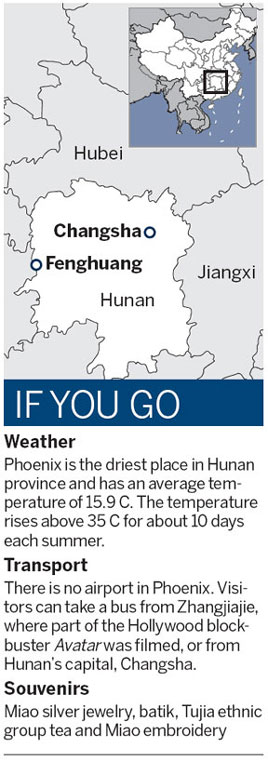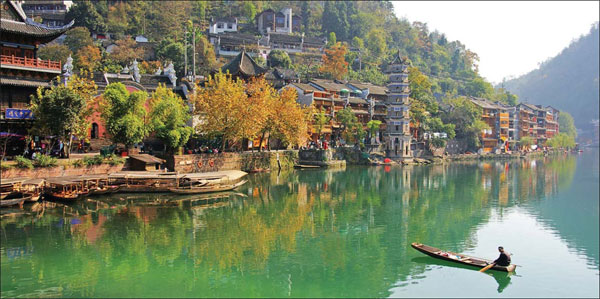Green waters, black magic
Updated: 2013-03-22 07:33
(China Daily)
|
||||||||
|
Boating on the Tuojiang River is an excellent way to take the old town's beauty. Provided to China Daily |
Eulogized in books, Phoenix is a town of beauty, but it also has a darker side of poisons and raising
Nobody knows who gave the name Phoenix to the picturesque town on the western border of central China's Hunan province, but it lives up to the name in beauty and mystery. Written about by Shen Congwen in the 1934 novella Border Town, Fenghuang, (which means phoenix), has since become a place of many travelers' dreams.
The town and its surrounding area are famous for natural beauty, colorful culture, their history and the Miao people's black magic.
Early in the day before 7 am is the best time to photograph this green city, when there are few people on the streets and views along the Tuojiang River, which winds its way through the old town, are ethereally beautiful.
Here are some of the city's main attractions:
1. Former residence of Shen Congwen
Phoenix is known across China through the writing of Shen. Although he left the town at the age of 15 he continued to eulogize it throughout his life and today his former home is the city's main tourist attraction.
It is said Shen's grandfather built the courtyard home in 1866 on the site of another building that he had torn down, after resigning from the Qing government.
The home consists of two parts separated by a patio. With wings on each end, the building looks both delicate and striking, and is a good example of architecture from the Ming (1368-1644) and Qing (1644-1911) dynasties.
Some original furniture remains inside the house, which is displayed alongside Shen family photographs and some of the poet's manuscripts.
2. Boating on the Tuojiang River

Winding like a green snake through the city's old town, the banks of the Tuojiang River are lined with picturesque houses on stilts and beyond them are mountains.
Boating on the river is an excellent way to take in the old town's beauty. At times the view from the river can look like a Chinese painting, with soft lines and warm colors. And at dusk the setting sun gilds the water's surface and silhouettes the surrounding buildings.
Boat rides begin at the North Gate and head downstream past Hongqiao Bridge, Wanming Tower and Wanshou Palace, each of which is worth a visit. Hongqiao Bridge, was built early in the Ming Dynasty, more than 600 years ago.
3. Miao villages
A trip to one of the Miao villages scattered around Phoenix is a must. The Miao ethnic group is famous across China for delicate handmade silver jewelry, including distinctive silver hats and necklaces that the women wear on special occasions.
Miao women are said to practice black magic, which often features in Chinese martial arts novels. The truth behind this is a real skill in making poisons using the venom of spiders, snakes and centipedes.
According to Miao tradition, if a body is buried in a bad area, Miao men can raise the corpse from the ground using ancient rituals and have it follow them to be laid to rest in a better location. Some villages around Phoenix perform tourist shows of this ancient belief.
The Miao Museum in Phoenix is a good place to learn more about Miao culture and black magic beliefs.
4. Qiliang cave
Four kilometers north of Phoenix, this 6,000 meter-long cave is home to a surreal collection of oddly shaped rocks, stalagmites and stalactites interspersed with springs and waterfalls. The cave is split into several areas, called ancient battlefield, gallery, paradise and dragon palace. A third of the cave's length has been developed as a tourist attraction.
5. The Ancient Town Museum
Housed in the former home of Chen Baozhen, a reformist senior official of the late Qing government, this museum showcases the history of the Chen family and Phoenix, and includes a sound and light show on the region's geography.
The Chen family has held a prominent place in Chinese history. Chen Baozhen's son Chen Sanli was a famous poet at the beginning of the Republic of China, his grandson Chen Hengke was a well-known painter and another family member Chen Maoke was a prominent historian.
The house covers more than 1,600 square meters and is over a century old.
China Daily
(China Daily 03/22/2013 page22)

 Li Na on Time cover, makes influential 100 list
Li Na on Time cover, makes influential 100 list
 FBI releases photos of 2 Boston bombings suspects
FBI releases photos of 2 Boston bombings suspects
 World's wackiest hairstyles
World's wackiest hairstyles
 Sandstorms strike Northwest China
Sandstorms strike Northwest China
 Never-seen photos of Madonna on display
Never-seen photos of Madonna on display
 H7N9 outbreak linked to waterfowl migration
H7N9 outbreak linked to waterfowl migration
 Dozens feared dead in Texas plant blast
Dozens feared dead in Texas plant blast
 Venezuelan court rules out manual votes counting
Venezuelan court rules out manual votes counting
Most Viewed
Editor's Picks

|

|

|

|

|

|
Today's Top News
Boston bombing suspect reported cornered on boat
7.0-magnitude quake hits Sichuan
Cross-talk artist helps to spread the word
'Green' awareness levels drop in Beijing
Palace Museum spruces up
First couple on Time's list of most influential
H7N9 flu transmission studied
Trading channels 'need to broaden'
US Weekly

|

|









